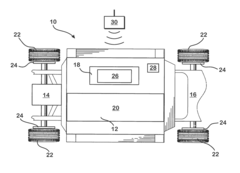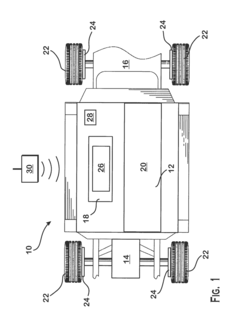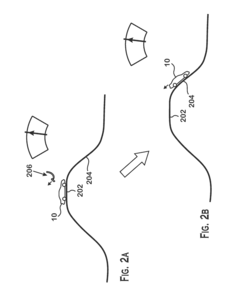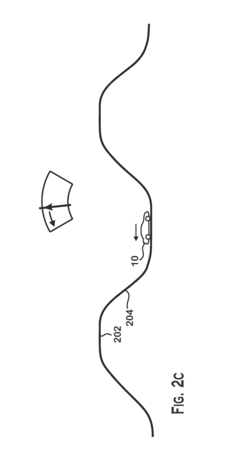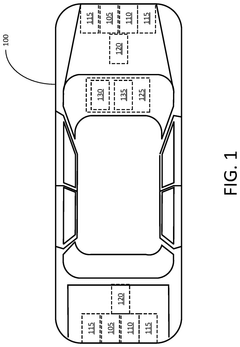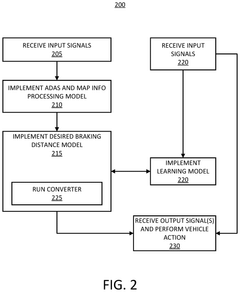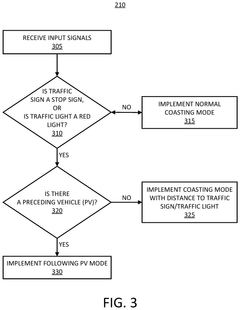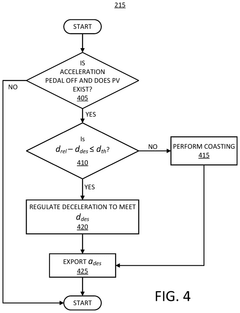The Interplay of Smart Technologies and Regenerative Braking
AUG 15, 20259 MIN READ
Generate Your Research Report Instantly with AI Agent
Patsnap Eureka helps you evaluate technical feasibility & market potential.
Smart Regen Tech Evolution
The evolution of smart regenerative braking technology has been marked by significant advancements in both hardware and software components. Initially, regenerative braking systems were simple, capturing only a fraction of the energy typically lost during deceleration. However, as automotive technology progressed, these systems became increasingly sophisticated.
In the early 2000s, hybrid vehicles introduced more advanced regenerative braking systems, which could recover a larger portion of kinetic energy. These systems utilized basic algorithms to determine when to engage regenerative braking and how much energy to capture. The integration of electronic stability control (ESC) systems in the mid-2000s further enhanced the effectiveness of regenerative braking by improving vehicle stability during energy recovery.
The next major leap came with the widespread adoption of electric vehicles (EVs) in the 2010s. This shift necessitated more efficient energy recovery systems to extend vehicle range. Manufacturers began implementing more powerful electric motors and higher-capacity batteries, allowing for greater energy capture and storage. Simultaneously, the development of more advanced power electronics enabled finer control over the regenerative braking process.
Smart technologies started playing a crucial role in regenerative braking around 2015. The integration of artificial intelligence (AI) and machine learning algorithms allowed systems to adapt to individual driving styles and road conditions. These smart systems could predict optimal moments for energy recovery, seamlessly blending regenerative and friction braking for maximum efficiency and driver comfort.
By 2018, vehicle-to-everything (V2X) communication began influencing regenerative braking strategies. Cars could now anticipate traffic patterns and adjust their energy recovery accordingly. This predictive capability not only improved energy efficiency but also enhanced safety by reducing the likelihood of sudden braking events.
The most recent developments in smart regenerative braking involve the integration of advanced sensor technologies. LiDAR and high-resolution cameras are now being used to create detailed 3D maps of the vehicle's surroundings, allowing for even more precise control of the regenerative braking system. These sensors enable the vehicle to anticipate changes in road gradient, traffic flow, and even pedestrian movements, further optimizing energy recovery.
Looking forward, the evolution of smart regenerative braking is likely to continue along several paths. One promising direction is the development of AI-powered systems that can learn and improve their performance over time, potentially leading to near-perfect energy recovery in various driving scenarios. Additionally, the integration of regenerative braking with other vehicle systems, such as active suspension and torque vectoring, may further enhance both efficiency and driving dynamics.
In the early 2000s, hybrid vehicles introduced more advanced regenerative braking systems, which could recover a larger portion of kinetic energy. These systems utilized basic algorithms to determine when to engage regenerative braking and how much energy to capture. The integration of electronic stability control (ESC) systems in the mid-2000s further enhanced the effectiveness of regenerative braking by improving vehicle stability during energy recovery.
The next major leap came with the widespread adoption of electric vehicles (EVs) in the 2010s. This shift necessitated more efficient energy recovery systems to extend vehicle range. Manufacturers began implementing more powerful electric motors and higher-capacity batteries, allowing for greater energy capture and storage. Simultaneously, the development of more advanced power electronics enabled finer control over the regenerative braking process.
Smart technologies started playing a crucial role in regenerative braking around 2015. The integration of artificial intelligence (AI) and machine learning algorithms allowed systems to adapt to individual driving styles and road conditions. These smart systems could predict optimal moments for energy recovery, seamlessly blending regenerative and friction braking for maximum efficiency and driver comfort.
By 2018, vehicle-to-everything (V2X) communication began influencing regenerative braking strategies. Cars could now anticipate traffic patterns and adjust their energy recovery accordingly. This predictive capability not only improved energy efficiency but also enhanced safety by reducing the likelihood of sudden braking events.
The most recent developments in smart regenerative braking involve the integration of advanced sensor technologies. LiDAR and high-resolution cameras are now being used to create detailed 3D maps of the vehicle's surroundings, allowing for even more precise control of the regenerative braking system. These sensors enable the vehicle to anticipate changes in road gradient, traffic flow, and even pedestrian movements, further optimizing energy recovery.
Looking forward, the evolution of smart regenerative braking is likely to continue along several paths. One promising direction is the development of AI-powered systems that can learn and improve their performance over time, potentially leading to near-perfect energy recovery in various driving scenarios. Additionally, the integration of regenerative braking with other vehicle systems, such as active suspension and torque vectoring, may further enhance both efficiency and driving dynamics.
Market Demand Analysis
The market demand for smart technologies integrated with regenerative braking systems has been steadily increasing, driven by the growing emphasis on energy efficiency and sustainability in the automotive and transportation sectors. This synergy between intelligent systems and energy recovery mechanisms is particularly evident in the electric and hybrid vehicle markets, where consumers are increasingly seeking vehicles that offer both advanced features and improved energy management.
In the passenger vehicle segment, the demand for cars equipped with regenerative braking and smart technologies has seen significant growth. Major automakers have reported a surge in sales of hybrid and electric vehicles that incorporate these systems. This trend is particularly strong in urban areas, where stop-and-go traffic conditions maximize the benefits of regenerative braking. The commercial vehicle sector, including buses and delivery vans, has also shown increased interest in these technologies, as fleet operators seek to reduce operational costs and meet stringent emissions regulations.
The market for smart regenerative braking systems extends beyond road vehicles. In the rail industry, there is a growing demand for trains equipped with intelligent energy recovery systems, especially in urban metro networks where frequent stops provide ample opportunities for energy regeneration. Similarly, the aerospace sector is exploring the potential of smart regenerative braking in aircraft landing gear systems, albeit at a more experimental stage.
The integration of smart technologies with regenerative braking has opened up new market opportunities in the aftermarket and retrofit sectors. There is a rising demand for upgrading existing vehicles with more advanced regenerative braking systems that can be controlled and optimized through smart algorithms. This trend is particularly strong in regions with aging vehicle fleets and stringent environmental regulations.
From a geographical perspective, the demand for these technologies is most pronounced in regions with advanced automotive industries and supportive regulatory environments. North America, Europe, and parts of Asia, particularly Japan and South Korea, are leading in the adoption of smart regenerative braking systems. However, emerging markets, especially China and India, are showing rapid growth in demand as they invest heavily in electric vehicle infrastructure and smart city initiatives.
The market demand is further bolstered by the increasing focus on autonomous and connected vehicles. As these technologies advance, the role of smart regenerative braking becomes more critical in optimizing energy usage and enhancing overall vehicle performance. This convergence of technologies is creating a new segment of highly efficient, intelligent vehicles that are attracting both individual consumers and fleet operators.
In conclusion, the market demand for the interplay of smart technologies and regenerative braking is robust and growing. It is driven by a combination of factors including environmental concerns, regulatory pressures, technological advancements, and changing consumer preferences. As the automotive industry continues its shift towards electrification and automation, the demand for these integrated systems is expected to accelerate further, creating significant opportunities for innovation and market growth.
In the passenger vehicle segment, the demand for cars equipped with regenerative braking and smart technologies has seen significant growth. Major automakers have reported a surge in sales of hybrid and electric vehicles that incorporate these systems. This trend is particularly strong in urban areas, where stop-and-go traffic conditions maximize the benefits of regenerative braking. The commercial vehicle sector, including buses and delivery vans, has also shown increased interest in these technologies, as fleet operators seek to reduce operational costs and meet stringent emissions regulations.
The market for smart regenerative braking systems extends beyond road vehicles. In the rail industry, there is a growing demand for trains equipped with intelligent energy recovery systems, especially in urban metro networks where frequent stops provide ample opportunities for energy regeneration. Similarly, the aerospace sector is exploring the potential of smart regenerative braking in aircraft landing gear systems, albeit at a more experimental stage.
The integration of smart technologies with regenerative braking has opened up new market opportunities in the aftermarket and retrofit sectors. There is a rising demand for upgrading existing vehicles with more advanced regenerative braking systems that can be controlled and optimized through smart algorithms. This trend is particularly strong in regions with aging vehicle fleets and stringent environmental regulations.
From a geographical perspective, the demand for these technologies is most pronounced in regions with advanced automotive industries and supportive regulatory environments. North America, Europe, and parts of Asia, particularly Japan and South Korea, are leading in the adoption of smart regenerative braking systems. However, emerging markets, especially China and India, are showing rapid growth in demand as they invest heavily in electric vehicle infrastructure and smart city initiatives.
The market demand is further bolstered by the increasing focus on autonomous and connected vehicles. As these technologies advance, the role of smart regenerative braking becomes more critical in optimizing energy usage and enhancing overall vehicle performance. This convergence of technologies is creating a new segment of highly efficient, intelligent vehicles that are attracting both individual consumers and fleet operators.
In conclusion, the market demand for the interplay of smart technologies and regenerative braking is robust and growing. It is driven by a combination of factors including environmental concerns, regulatory pressures, technological advancements, and changing consumer preferences. As the automotive industry continues its shift towards electrification and automation, the demand for these integrated systems is expected to accelerate further, creating significant opportunities for innovation and market growth.
Current Tech Challenges
The integration of smart technologies with regenerative braking systems presents both significant opportunities and challenges in the current automotive landscape. One of the primary challenges lies in optimizing the energy recovery efficiency of regenerative braking systems. While the concept is well-established, achieving maximum energy recapture across diverse driving conditions remains a complex task.
Smart technologies, particularly advanced sensors and artificial intelligence, are being leveraged to address this challenge. However, the seamless integration of these technologies with existing brake-by-wire systems poses a significant hurdle. Ensuring real-time data processing and decision-making without compromising safety or performance is a critical concern for manufacturers and engineers alike.
Another pressing challenge is the development of more sophisticated energy management systems. As vehicles become increasingly electrified, the interplay between regenerative braking and battery management becomes more crucial. Smart technologies are needed to optimize the balance between energy recovery, battery health, and overall vehicle efficiency. This requires complex algorithms that can adapt to various driving styles, road conditions, and vehicle loads.
The durability and longevity of regenerative braking systems when coupled with smart technologies is another area of concern. The increased reliance on electronic components and software in these systems raises questions about long-term reliability and maintenance requirements. Manufacturers must ensure that these advanced systems can withstand the rigors of daily use and varying environmental conditions over the vehicle's lifetime.
Standardization and interoperability present additional challenges in this rapidly evolving field. As different manufacturers develop proprietary smart regenerative braking systems, ensuring compatibility across platforms and with future technologies becomes increasingly important. This is particularly relevant in the context of connected and autonomous vehicles, where standardized communication protocols are essential for optimal performance and safety.
Cost considerations also play a significant role in the widespread adoption of smart regenerative braking technologies. While these systems offer substantial benefits in terms of efficiency and performance, the additional complexity and components can increase vehicle production costs. Striking a balance between advanced features and affordability remains a key challenge for automakers targeting mass-market adoption.
Lastly, the regulatory landscape surrounding these technologies is still evolving. As smart regenerative braking systems become more sophisticated, regulatory bodies must keep pace to ensure safety standards are met while not stifling innovation. This requires a delicate balance between stringent safety requirements and the flexibility needed to accommodate rapidly advancing technologies.
Smart technologies, particularly advanced sensors and artificial intelligence, are being leveraged to address this challenge. However, the seamless integration of these technologies with existing brake-by-wire systems poses a significant hurdle. Ensuring real-time data processing and decision-making without compromising safety or performance is a critical concern for manufacturers and engineers alike.
Another pressing challenge is the development of more sophisticated energy management systems. As vehicles become increasingly electrified, the interplay between regenerative braking and battery management becomes more crucial. Smart technologies are needed to optimize the balance between energy recovery, battery health, and overall vehicle efficiency. This requires complex algorithms that can adapt to various driving styles, road conditions, and vehicle loads.
The durability and longevity of regenerative braking systems when coupled with smart technologies is another area of concern. The increased reliance on electronic components and software in these systems raises questions about long-term reliability and maintenance requirements. Manufacturers must ensure that these advanced systems can withstand the rigors of daily use and varying environmental conditions over the vehicle's lifetime.
Standardization and interoperability present additional challenges in this rapidly evolving field. As different manufacturers develop proprietary smart regenerative braking systems, ensuring compatibility across platforms and with future technologies becomes increasingly important. This is particularly relevant in the context of connected and autonomous vehicles, where standardized communication protocols are essential for optimal performance and safety.
Cost considerations also play a significant role in the widespread adoption of smart regenerative braking technologies. While these systems offer substantial benefits in terms of efficiency and performance, the additional complexity and components can increase vehicle production costs. Striking a balance between advanced features and affordability remains a key challenge for automakers targeting mass-market adoption.
Lastly, the regulatory landscape surrounding these technologies is still evolving. As smart regenerative braking systems become more sophisticated, regulatory bodies must keep pace to ensure safety standards are met while not stifling innovation. This requires a delicate balance between stringent safety requirements and the flexibility needed to accommodate rapidly advancing technologies.
Smart Regen Solutions
01 Energy recovery systems for regenerative braking
Advanced energy recovery systems are implemented to capture and store kinetic energy during braking. These systems typically involve electric motors, generators, and energy storage devices like batteries or supercapacitors. By efficiently converting kinetic energy into electrical energy, these systems significantly improve the overall energy efficiency of vehicles, particularly in urban driving conditions with frequent stops.- Optimization of regenerative braking systems: Improving the efficiency of regenerative braking systems through advanced control strategies, energy recovery algorithms, and system integration. This includes optimizing the balance between friction and regenerative braking, adapting to various driving conditions, and maximizing energy recuperation while maintaining vehicle stability and comfort.
- Energy storage and management: Enhancing energy storage capabilities and management systems to effectively capture, store, and utilize regenerative braking energy. This involves developing advanced battery technologies, supercapacitors, or hybrid energy storage solutions, as well as implementing intelligent energy management algorithms to optimize power distribution and overall system efficiency.
- Integration with electric and hybrid powertrains: Seamlessly integrating regenerative braking systems with electric and hybrid vehicle powertrains to maximize overall energy efficiency. This includes coordinating regenerative braking with electric motor operation, optimizing power flow between different components, and adapting the system to various driving modes and vehicle configurations.
- Adaptive and predictive regenerative braking: Implementing adaptive and predictive regenerative braking strategies that anticipate driving conditions, traffic patterns, and road topography. This involves using sensors, GPS data, and machine learning algorithms to optimize energy recovery in real-time, adjusting regenerative braking intensity based on predicted energy demands and opportunities for energy recuperation.
- Mechanical and hydraulic system improvements: Enhancing the mechanical and hydraulic components of regenerative braking systems to improve energy conversion efficiency and reduce losses. This includes developing advanced brake actuators, optimizing hydraulic circuits, and implementing innovative mechanical designs to capture and convert kinetic energy more effectively during braking events.
02 Optimization of braking force distribution
Intelligent control systems are developed to optimize the distribution of braking force between regenerative and friction braking. These systems analyze various factors such as vehicle speed, battery state of charge, and road conditions to determine the most efficient braking strategy. By maximizing the use of regenerative braking while ensuring vehicle stability and safety, these systems enhance energy recovery and overall braking performance.Expand Specific Solutions03 Integration with hybrid and electric powertrains
Regenerative braking systems are seamlessly integrated with hybrid and electric vehicle powertrains to maximize energy efficiency. This integration involves sophisticated power management algorithms that coordinate between the electric motor, internal combustion engine (in hybrids), and energy storage systems. By optimizing the flow of energy during acceleration, cruising, and braking, these integrated systems significantly improve overall vehicle efficiency.Expand Specific Solutions04 Advanced energy storage technologies
Innovative energy storage technologies are developed to improve the efficiency of regenerative braking systems. These include high-performance batteries, supercapacitors, and flywheel energy storage systems. These advanced storage solutions offer rapid charge and discharge capabilities, high energy density, and long cycle life, enabling more efficient capture and utilization of braking energy.Expand Specific Solutions05 Predictive and adaptive braking strategies
Intelligent braking systems employ predictive and adaptive strategies to enhance regenerative braking efficiency. These systems use data from various sensors, GPS, and vehicle-to-infrastructure communication to anticipate braking events. By adjusting regenerative braking parameters in real-time based on driving conditions and route information, these strategies maximize energy recovery while maintaining optimal vehicle performance and driver comfort.Expand Specific Solutions
Key Industry Players
The interplay of smart technologies and regenerative braking is in a growth phase, with increasing market size and technological advancements. The global market for regenerative braking systems is expanding rapidly, driven by the growing demand for electric and hybrid vehicles. Companies like Hyundai Motor, Toyota, Ford, and General Motors are at the forefront of this technology, investing heavily in research and development. The technology's maturity is advancing, with major players like Renault, Kia, and Nissan continuously improving efficiency and integration with other smart vehicle systems. As the automotive industry shifts towards electrification, this technology is becoming increasingly crucial for energy conservation and vehicle performance optimization.
Hyundai Motor Co., Ltd.
Technical Solution: Hyundai has developed an advanced regenerative braking system that integrates with smart technologies to maximize energy recovery and improve overall vehicle efficiency. Their system utilizes predictive algorithms and real-time data from various sensors to optimize brake energy recuperation. The system adapts to driving conditions, traffic patterns, and road topography to seamlessly blend regenerative and friction braking[1]. Hyundai's smart regenerative braking also incorporates machine learning to continuously improve its performance over time, learning from individual driving habits and routes[3]. Additionally, they have implemented a paddle-shift control for drivers to manually adjust regenerative braking levels, providing a more engaging and customizable driving experience[5].
Strengths: Adaptive system that optimizes energy recovery, seamless integration with other vehicle systems, and user-friendly controls. Weaknesses: May require more complex hardware and software, potentially increasing costs and maintenance complexity.
Ford Global Technologies LLC
Technical Solution: Ford has developed a smart regenerative braking system that leverages connected vehicle technology and artificial intelligence to enhance energy recovery and vehicle efficiency. Their system uses vehicle-to-vehicle (V2V) and vehicle-to-infrastructure (V2I) communication to anticipate traffic conditions and adjust regenerative braking accordingly[2]. Ford's technology also incorporates weather data and road gradient information to optimize brake energy recuperation. The system employs a sophisticated algorithm that balances between maximizing energy recovery and maintaining driver comfort[4]. Furthermore, Ford has integrated their regenerative braking system with their adaptive cruise control and collision avoidance systems, creating a holistic approach to vehicle energy management and safety[6].
Strengths: Advanced connectivity features, holistic integration with other vehicle systems, and potential for improved safety. Weaknesses: Reliance on external infrastructure for optimal performance, which may not be available in all areas.
Core Innovations Review
Smart regenerative braking control
PatentActiveUS20180079312A1
Innovation
- The smart braking system detects triggering conditions such as acceleration without accelerator input or excessive slope-related acceleration and activates the braking system to maintain the current speed, using a combination of friction and regenerative braking, without automatically applying the accelerator, and can be enabled or disabled by the driver.
Smart regen braking incorporating learned driver braking habits
PatentPendingUS20240375656A1
Innovation
- Implementing a smart regenerative braking system that uses sensors and an advanced driver-assistance system (ADAS) with a learning model to determine calibration factors based on driver braking habits, converting desired deceleration into motor torque, and adjusting braking modes accordingly.
Energy Efficiency Impact
The integration of smart technologies with regenerative braking systems has significantly enhanced energy efficiency in various transportation sectors, particularly in electric and hybrid vehicles. This synergy has led to substantial improvements in overall vehicle performance and energy conservation.
Regenerative braking, a key feature in modern electric and hybrid vehicles, converts kinetic energy into electrical energy during deceleration. Smart technologies have optimized this process, allowing for more precise control and energy recovery. Advanced sensors and predictive algorithms now enable vehicles to anticipate braking scenarios, maximizing energy recapture opportunities.
The impact on energy efficiency is multifaceted. Firstly, the enhanced regenerative braking systems can recover up to 70% of the vehicle's kinetic energy, which would otherwise be lost as heat in conventional braking systems. This recovered energy is then stored in the vehicle's battery, extending the driving range and reducing the frequency of charging or refueling.
Smart technologies have also improved the seamless integration of regenerative braking with traditional friction brakes. This blended braking approach ensures optimal energy recovery without compromising vehicle safety or driver comfort. Adaptive systems can now adjust the regenerative braking force based on road conditions, vehicle speed, and driver behavior, further maximizing efficiency.
Moreover, the interplay between smart technologies and regenerative braking has led to the development of more sophisticated energy management systems. These systems can dynamically allocate power between the electric motor and internal combustion engine in hybrid vehicles, prioritizing electric power usage and minimizing fuel consumption.
The energy efficiency gains extend beyond individual vehicle performance. In urban environments, where stop-and-go traffic is common, the widespread adoption of smart regenerative braking systems could lead to significant reductions in overall energy consumption and emissions. This technology is particularly impactful in public transportation, where frequent stops provide ample opportunities for energy recovery.
Looking ahead, the continued evolution of smart technologies promises even greater energy efficiency improvements. Machine learning algorithms are being developed to optimize regenerative braking strategies based on historical driving data and real-time traffic conditions. This predictive approach could further enhance energy recovery and overall vehicle efficiency.
Regenerative braking, a key feature in modern electric and hybrid vehicles, converts kinetic energy into electrical energy during deceleration. Smart technologies have optimized this process, allowing for more precise control and energy recovery. Advanced sensors and predictive algorithms now enable vehicles to anticipate braking scenarios, maximizing energy recapture opportunities.
The impact on energy efficiency is multifaceted. Firstly, the enhanced regenerative braking systems can recover up to 70% of the vehicle's kinetic energy, which would otherwise be lost as heat in conventional braking systems. This recovered energy is then stored in the vehicle's battery, extending the driving range and reducing the frequency of charging or refueling.
Smart technologies have also improved the seamless integration of regenerative braking with traditional friction brakes. This blended braking approach ensures optimal energy recovery without compromising vehicle safety or driver comfort. Adaptive systems can now adjust the regenerative braking force based on road conditions, vehicle speed, and driver behavior, further maximizing efficiency.
Moreover, the interplay between smart technologies and regenerative braking has led to the development of more sophisticated energy management systems. These systems can dynamically allocate power between the electric motor and internal combustion engine in hybrid vehicles, prioritizing electric power usage and minimizing fuel consumption.
The energy efficiency gains extend beyond individual vehicle performance. In urban environments, where stop-and-go traffic is common, the widespread adoption of smart regenerative braking systems could lead to significant reductions in overall energy consumption and emissions. This technology is particularly impactful in public transportation, where frequent stops provide ample opportunities for energy recovery.
Looking ahead, the continued evolution of smart technologies promises even greater energy efficiency improvements. Machine learning algorithms are being developed to optimize regenerative braking strategies based on historical driving data and real-time traffic conditions. This predictive approach could further enhance energy recovery and overall vehicle efficiency.
Regulatory Framework
The regulatory framework surrounding smart technologies and regenerative braking systems plays a crucial role in shaping the development, implementation, and adoption of these innovative solutions in the automotive industry. Governments and regulatory bodies worldwide have recognized the potential of these technologies to improve energy efficiency and reduce emissions, leading to the establishment of various policies and standards.
In the United States, the National Highway Traffic Safety Administration (NHTSA) has implemented regulations that encourage the adoption of regenerative braking systems as part of broader fuel efficiency standards. The Corporate Average Fuel Economy (CAFE) standards incentivize automakers to incorporate advanced technologies, including regenerative braking, to meet increasingly stringent fuel economy targets. Similarly, the Environmental Protection Agency (EPA) has set emissions standards that indirectly promote the use of regenerative braking systems to reduce overall vehicle emissions.
The European Union has taken a proactive approach in regulating smart technologies and regenerative braking. The European Commission's Regulation (EU) 2019/631 sets CO2 emission performance standards for new passenger cars and light commercial vehicles, encouraging manufacturers to adopt innovative technologies like regenerative braking. Additionally, the EU's type-approval regulations for electric and hybrid vehicles include specific requirements for regenerative braking systems, ensuring their safety and effectiveness.
In China, the world's largest automotive market, the government has implemented policies to promote new energy vehicles (NEVs) and associated technologies. The Ministry of Industry and Information Technology (MIIT) has issued guidelines that specifically address regenerative braking systems in electric and hybrid vehicles, setting performance and safety standards for their implementation.
Globally, the United Nations Economic Commission for Europe (UNECE) has developed regulations under the 1958 Agreement, which provide a framework for the approval of vehicle systems, including those related to regenerative braking. These regulations, such as UN Regulation No. 13-H, establish uniform technical prescriptions for braking systems, including specific provisions for electric regenerative braking systems.
As smart technologies continue to evolve, regulatory frameworks are adapting to address new challenges and opportunities. For instance, the integration of artificial intelligence and machine learning in regenerative braking systems has prompted discussions on data privacy and cybersecurity regulations. Regulatory bodies are working to develop standards that ensure the secure operation of these advanced systems while protecting user data.
The interplay between smart technologies and regenerative braking has also led to the development of new testing and certification procedures. Regulatory agencies are updating their methodologies to accurately assess the performance and efficiency gains provided by these integrated systems, ensuring that claimed benefits are verifiable and consistent across different vehicle models and manufacturers.
In the United States, the National Highway Traffic Safety Administration (NHTSA) has implemented regulations that encourage the adoption of regenerative braking systems as part of broader fuel efficiency standards. The Corporate Average Fuel Economy (CAFE) standards incentivize automakers to incorporate advanced technologies, including regenerative braking, to meet increasingly stringent fuel economy targets. Similarly, the Environmental Protection Agency (EPA) has set emissions standards that indirectly promote the use of regenerative braking systems to reduce overall vehicle emissions.
The European Union has taken a proactive approach in regulating smart technologies and regenerative braking. The European Commission's Regulation (EU) 2019/631 sets CO2 emission performance standards for new passenger cars and light commercial vehicles, encouraging manufacturers to adopt innovative technologies like regenerative braking. Additionally, the EU's type-approval regulations for electric and hybrid vehicles include specific requirements for regenerative braking systems, ensuring their safety and effectiveness.
In China, the world's largest automotive market, the government has implemented policies to promote new energy vehicles (NEVs) and associated technologies. The Ministry of Industry and Information Technology (MIIT) has issued guidelines that specifically address regenerative braking systems in electric and hybrid vehicles, setting performance and safety standards for their implementation.
Globally, the United Nations Economic Commission for Europe (UNECE) has developed regulations under the 1958 Agreement, which provide a framework for the approval of vehicle systems, including those related to regenerative braking. These regulations, such as UN Regulation No. 13-H, establish uniform technical prescriptions for braking systems, including specific provisions for electric regenerative braking systems.
As smart technologies continue to evolve, regulatory frameworks are adapting to address new challenges and opportunities. For instance, the integration of artificial intelligence and machine learning in regenerative braking systems has prompted discussions on data privacy and cybersecurity regulations. Regulatory bodies are working to develop standards that ensure the secure operation of these advanced systems while protecting user data.
The interplay between smart technologies and regenerative braking has also led to the development of new testing and certification procedures. Regulatory agencies are updating their methodologies to accurately assess the performance and efficiency gains provided by these integrated systems, ensuring that claimed benefits are verifiable and consistent across different vehicle models and manufacturers.
Unlock deeper insights with Patsnap Eureka Quick Research — get a full tech report to explore trends and direct your research. Try now!
Generate Your Research Report Instantly with AI Agent
Supercharge your innovation with Patsnap Eureka AI Agent Platform!
